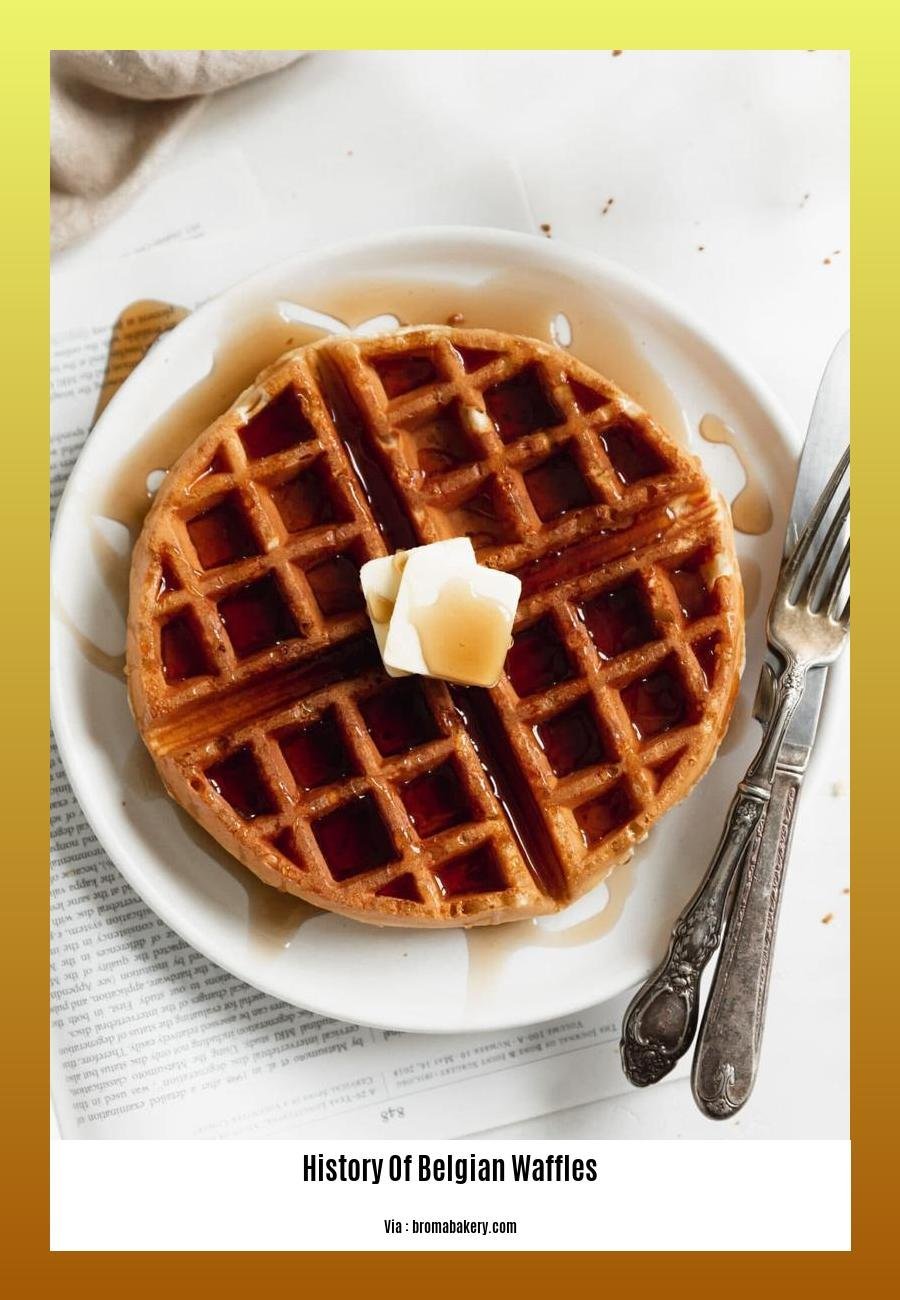Throughout history, food has played a crucial role in shaping cultures and bringing people together. The Belgian waffle, with its unique texture and delicious taste, is no exception. Join us on a culinary journey through time as we explore The History of Belgian Waffles: A Culinary Journey Through Time. Discover the origins of this beloved breakfast treat, its evolution across cultures, and the unique characteristics that make it a global favorite.
Key Takeaways:
The Belgian waffle is a culinary icon with a rich history and tradition.
It stands out with its thicker and denser texture due to the use of yeast-leavened batter.
Its global recognition stems from its appearance at the 1958 Expo in Brussels and its introduction to the United States by Walter Cleyman in 1962.
The classic presentation of Belgian waffles includes whipped cream, strawberries, and powdered sugar, making it a visually appealing and delicious treat.
Beyond breakfast, Belgian waffles have gained popularity as a beloved dessert, enjoyed worldwide.
The History of Belgian Waffles

Belgian waffles, with their crispy golden exterior and fluffy, yeasty interior, have a rich history that dates back centuries. Embark on a culinary journey through time as we explore the intriguing origins and evolution of this beloved breakfast treat.
Humble Beginnings: A Belgian Legacy
The history of belgian waffles takes us back to medieval Belgium, where they were originally known as oublies or gaufres. These early waffles were thin, unleavened cakes cooked between hot iron plates.
Over time, the recipe evolved, and yeast was introduced to the batter, resulting in a thicker, lighter, and more flavorful waffle.
By the 18th century, Belgian waffles had become a staple of Belgian cuisine, enjoyed by people from all walks of life.
A Global Phenomenon: Belgian Waffles Take the World by Storm
The true rise of the belgian waffle can be traced back to the 1958 Brussels World’s Fair. It was here that Maurice Vermersch, a Belgian baker, introduced his delicious waffles to the world.
Vermersch’s waffles were an instant hit, and they quickly became a symbol of Belgian cuisine.
In the years that followed, belgian waffles spread throughout Europe and beyond, eventually becoming a beloved breakfast food around the globe.
Unique Characteristics: What Makes Belgian Waffles Special?
Several distinctive features set belgian waffles apart from their counterparts:
Yeast-Leavened Batter: Unlike American waffles, which are typically made with baking powder or baking soda, belgian waffles use yeast as their leavening agent. This results in a dough that is light, airy, and slightly tangy.
Deep Pockets: Belgian waffles are known for their deep pockets, which are perfect for holding syrup, fruit, or other toppings.
Crispy Exterior: The high sugar content in the batter caramelizes during cooking, creating a crispy, caramelized exterior that contrasts beautifully with the fluffy interior.
Global Variations: Belgian Waffles Around the World
While the classic Belgian waffle remains a popular choice, there are many variations of this delicious treat around the world:
American Waffles: American waffles are typically thinner and crispier than Belgian waffles. They are also made with baking powder or baking soda instead of yeast.
Dutch Stroopwafels: These thin, caramel-filled waffles are a popular treat in the Netherlands. They are made from two thin layers of baked dough filled with a sweet, syrupy caramel filling.
French Gaufres: French waffles are similar to Belgian waffles but are usually made with a batter that includes eggs whites, which gives them a lighter texture.
No matter how you like your waffles, there’s no denying that the Belgian waffle is a culinary icon that has captured the hearts and taste buds of people around the world.
History of Asian cuisine is a mouthwatering journey spanning over several millennia. This comprehensive guide takes you on a culinary adventure across continents, exploring the diverse flavors and techniques that have shaped Asian cuisine into the globally celebrated culinary sensation it is today. Immerse yourself in a symphony of spices, vibrant ingredients, and fascinating traditions.
Discover the History of Candy and its sweet legacy. Candy has been tempting our taste buds for centuries, and it continues to surprise and delight us with its vast array of flavors, shapes, and textures. From the ancient Egyptians to modern confectioners, this article explores the fascinating journey of candy, shedding light on its origins, evolution, and the scientific secrets behind its irresistible appeal. Let’s embark on a sugary adventure through time!
Belgian Waffle Iron and its Significance

Have you ever wondered how the Belgian waffle came to be, or why it’s so different from its American counterpart? In this article, we’ll take a culinary journey through time to explore the history and significance of the Belgian waffle iron, a tool that has played a crucial role in shaping this iconic breakfast treat.
Belgian waffles, with their deep pockets, crisp exterior, and fluffy interior, are a far cry from the thin, crispy waffles we’re used to in America. This unique texture and flavor profile can be attributed to the Belgian waffle iron, a specialized cooking tool that has been perfecting the art of waffle-making for centuries.
Key Takeaways:
Belgian waffles originated in Belgium, specifically in the capital city of Brussels.
The two main types of Belgian waffles are Brussels waffles and Liège waffles, each with its own distinct characteristics.
Brussels waffles are characterized by their rectangular shape, deep pockets, and yeast-based batter, which gives them a light and airy texture.
Liège waffles, on the other hand, are known for their round shape, pearl sugar chunks embedded in the batter, and a denser, chewier texture.
The Belgian waffle iron is a crucial tool in creating the signature deep pockets and crispy exterior of Belgian waffles.
The waffle iron’s unique design, with its deep grids and heat distribution system, allows the batter to cook evenly, resulting in a perfectly golden brown waffle.
The Belgian waffle iron has played a significant role in popularizing Belgian waffles around the world, making them a beloved breakfast treat enjoyed by people of all ages.
Now, let’s take a closer look at the history and evolution of the Belgian waffle iron to understand its significance in shaping this culinary delight:
A Culinary Journey:
Waffles have been around for centuries, but it was in Belgium that they truly came into their own. Belgian waffles, as we know them today, originated in the 18th century, when enterprising bakers began experimenting with new recipes and cooking techniques.
The development of the Belgian waffle iron was a pivotal moment in the history of waffles. These specialized irons, with their deep grids and unique heat distribution system, allowed for the creation of waffles with deep pockets and a crispy exterior, which became the hallmark of Belgian waffles.
The Belgian waffle iron quickly gained popularity, and by the 19th century, it had become a staple in Belgian households. The aroma of freshly baked waffles filled the streets of Belgian cities, and waffle stands became a common sight.
The Belgian waffle iron’s significance extends beyond its functionality. It has become a symbol of Belgian culinary heritage, representing the country’s rich tradition of baking and pastry-making. The waffle iron has also played a crucial role in promoting Belgian waffles on a global scale, making them a beloved breakfast treat enjoyed around the world.
In Conclusion:
The Belgian waffle iron is not just a cooking tool; it’s a symbol of culinary heritage and a testament to the ingenuity of Belgian bakers. Through its unique design and cooking capabilities, the Belgian waffle iron has shaped the Belgian waffle into the iconic breakfast treat we know and love today. So, the next time you indulge in a delicious Belgian waffle, take a moment to appreciate the role that the Belgian waffle iron has played in bringing this culinary delight to your plate.
Sources:
History and origins of Brussels waffle
History of Belgian Waffles
Global Spread and Popularity
Belgian waffles didn’t just magically appear on our plates, and if they did, they chose the right place to land. They have a rich history that spans cultures and continents, and their journey to global prominence is a tale worth telling.
Expo 58 was a game-changer. Maurice Vermersch, a Belgian waffle master, showcased his delectable creations in 1958, earning the attention of the world. And just like that, the Belgian waffle was thrust into the international spotlight.
The World’s Fairs were their runway. In 1962, the Century 21 Exposition in Seattle and the 1964 New York World’s Fair became the Belgian waffle’s catwalk. They strutted their stuff, tantalizing taste buds and leaving a trail of cravings in their wake.
The States fell head over heels. Americans couldn’t resist the allure of these golden treats. In the 1960s, Belgian waffles crossed the Atlantic and quickly became a beloved breakfast staple, gracing diners and IHOPs nationwide.
They’ve taken on the world. Today, Belgian waffles aren’t just a Belgian thing; they’re a global phenomenon. From Paris to Tokyo, Sydney to Rio, these waffles have conquered hearts and taste buds, becoming a symbol of culinary delight.
Key Takeaways:
- Belgian waffles owe their global fame to Maurice Vermersch, who presented them at Expo 58.
- World’s Fairs in Seattle and New York further boosted their popularity in the 1960s.
- The United States welcomed Belgian waffles with open arms, making them a breakfast staple.
- Today, Belgian waffles are adored worldwide, transcending borders and cultures.
Sources:
- History and origins of Brussels waffle: a delicious specialty from Belgium
- Belgian Waffle Day: A History of the Breakfast Food
Variations and Adaptations: A Symphony of Waffles
Imagine a world without the symphony of flavors and textures that is the Belgian waffle. It’s a culinary journey that has taken us from medieval kitchens to modern-day breakfast tables, with countless variations and adaptations along the way.
Key Takeaways:
Belgian waffles originated in Belgium, showcasing a unique batter, deep pockets, and crispy exterior.
The Brussels waffle, the most popular variation, boasts rectangular shapes and deep pockets, often accompanied by luscious toppings.
Liège waffles, another Belgian specialty, feature a caramelized sugar pearl interior, creating a delightful crunch.
Globally, waffles have undergone transformations:
- American waffles are thinner and crispier, often using baking powder or soda.
- Dutch stroopwafels are thin, caramel-filled wonders.
French gaufres have a lighter texture due to egg whites in the batter.
These adaptations reflect cultural preferences and culinary traditions, creating a diverse waffle landscape.
The Brussels Waffle: A Classic with Endless Possibilities
Picture this: a golden rectangle with deep pockets, ready to embrace a variety of toppings. The Brussels waffle is the quintessential Belgian waffle, a canvas for creativity. From whipped cream and strawberries to chocolate sauce and ice cream, the possibilities are endless.
Liège Waffles: A Caramelized Delight
Hailing from the city of Liège, these waffles boast a unique twist: caramelized sugar pearls baked right into the batter. The result? A crispy exterior with a soft, chewy interior, offering a burst of caramelized sweetness in every bite.
A Global Waffle Extravaganza
The Belgian waffle’s journey has extended far beyond its homeland, inspiring diverse variations across the globe:
- American waffles: Thinner and crispier, often using baking powder or soda for leavening.
- Dutch stroopwafels: Thin, caramel-filled waffles, perfect for a sweet treat.
- French gaufres: Lighter in texture due to whipped egg whites in the batter.
A Culinary Legacy: Past, Present, and Future
From humble beginnings in medieval kitchens to their current status as global breakfast stars, Belgian waffles have stood the test of time. Their variations and adaptations reflect the ever-evolving nature of cuisine, where culinary traditions blend and new flavors emerge.
Sources:
- History and origins of Brussels waffle: a delicious specialty from Belgium
- Belgian waffle – Wikipedia
FAQ
Q1: How did Belgian waffles originate?
A1: Belgian waffles, also known as Brussels waffles, originated in Brussels, Belgium, during the Middle Ages. Initially crafted from oats, flour, and eggs, they have since become a staple Belgian dish.
Q2: What is the difference between Belgian waffles and American waffles?
A2: Belgian waffles are typically thicker and denser than American waffles and have a lighter batter, larger squares, and deeper pockets. They are also traditionally leavened with yeast, while American waffles are usually leavened with baking powder.
Q3: Why are Belgian waffles so popular?
A3: Belgian waffles are popular due to their unique flavor and texture. They are crispy on the outside and fluffy on the inside, with a caramelized crust that adds a delicious flavor. They are also a versatile dish that can be served with a variety of toppings, making them a popular choice for breakfast, brunch, or dessert.
Q4: What are the different types of Belgian waffles?
A4: The two main types of Belgian waffles are Brussels waffles and Liège waffles. Brussels waffles are the most common type and are characterized by their rectangular shape and deep pockets. Liège waffles, on the other hand, are round and have a denser texture due to the addition of pearl sugar.
Q5: How are Belgian waffles traditionally served?
A5: Belgian waffles are traditionally served in cafes and restaurants in Belgium, accompanied by an array of flavors and toppings. Common toppings include whipped cream, powdered sugar, soft fruits, chocolate spread, and ice cream. They can also be served with savory toppings such as cheese and ham.
- China II Review: Delicious Food & Speedy Service - April 17, 2025
- Understand Virginia’s Flag: History & Debate - April 17, 2025
- Explore Long Island’s Map: Unique Regions & Insights - April 17, 2025
















